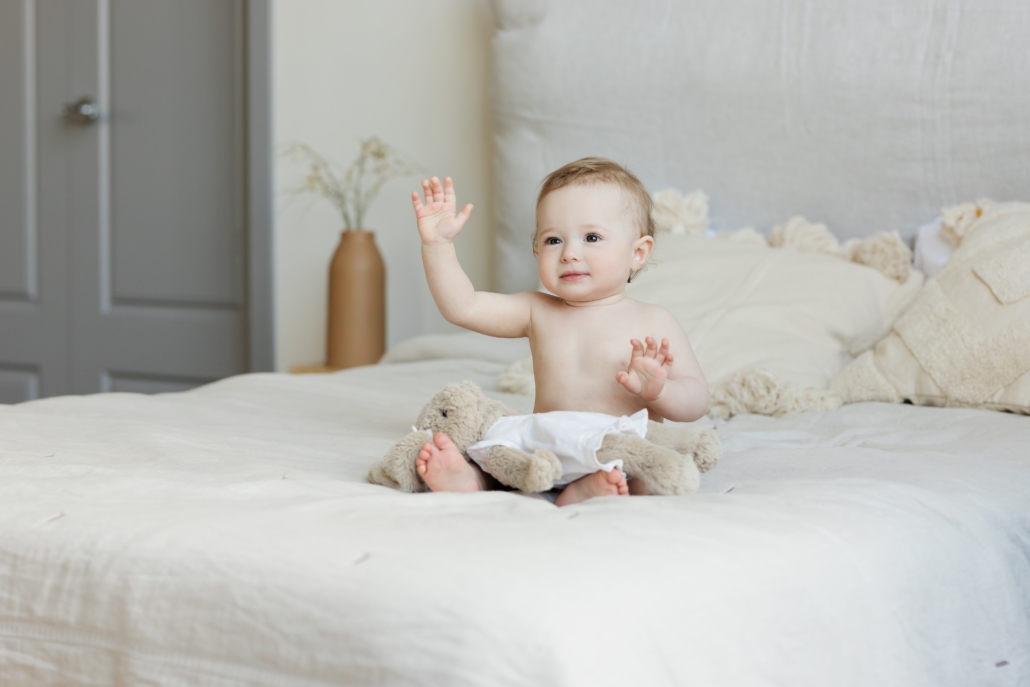

- Call 908 543 4390
- Email
- Dr.Joni Redlich PT,DPT



“My baby won’t move out of sitting! She just wants to sit and play and gets mad if we lie her down to play!”
It’s an exciting moment when your baby starts sitting all by themselves. At some point between 5-8 months babies developing typically will gain the postural control to sit hands free and play with toys.
It’s a huge milestone and a big one to celebrate!
Here’s a photo of the first time my daughter, Rebekah, sat by herself. She sat just long enough for me to snap a quick pic!
You can see how tentative she looks here!
Rebekah is using her hands to help her balance here.
She’s not quite ready to sit and play with toys with both hands, watch the dog running back and forth, or reach for something.
Perhaps a big giggle would knock her over at this point!
This is a great time to play in sitting with a little support, such as in a laundry basket or a box.
The more filled the basket, the easier it will be to balance. For more challenge, try wiggling the laundry basket or give your baby a ride moving the basket back and forth.
You can also use large toys where your baby can use one hand to balance and the other to like this one.
Many of the push toys have a side to play on- park it against a wall of the couch so it won’t move and your baby can sit and play with it.
A big toy that fits in between your babies legs in ring sit so they balance with their hands on the toy, rather than hands on the floor can help sitting balance get better and better.
When babies become more experienced sitters, they can look in all directions without it impacting their balance, they can play with toys with both hands and they can reach in all directions.
This is when you’ll see your baby experimenting with banging toys together and using both hands to manipulate their toys.
Once we’ve mastered the sitting milestone, now what?
In sitting, we want to see your baby shift their weight forward and back, left and right, while they’re playing in sitting.
They will learn this naturally during play.
While they’re shifting their weight to each side to get the things they want, your baby will learn to move from a ring sit position like above to other positions, such as ring sit to side sit.
Babies will also move from sitting down to their bellies too.
Here are some examples of playing in sitting that leads to next steps and moving in and out of sitting:
This give babies the opportunities to practice moving between positions from sitting to belly and from sitting to hands and knees.
All of this movement out of sitting creates separation from the babies’ lower legs, hips, and core, building flexibility and postural control.
This is getting the baby ready for all of the milestones that come next!
The stage is being set for crawling and walking!
What are happy sitters?
Happy sitters are babies who achieve the exciting sitting milestone that we’re chatting about, but then they bask in the glory of sitting and don’t keep moving along in the developmental process.
Our therapists at Kid PT see this all the time.
These babies figure out how to communicate to their parents to place them in sitting. These babies will pull toys towards them using a blanket and will have siblings bring them the things they want. They are so smart and problem ways to keep things in their comfort zone!
We call these babies “happy sitters” because they’re happy sitting there, but aren’t happy exploring other ways to move.
Although learning to sit by themselves is fantastic, it should happen alongside:
If your baby is sitting all by themselves, but they aren’t doing the other movements listed above, your baby may be a happy sitter.
What happens if you don’t intervene?
The longer you wait, the harder it is to promote more movement.
Variety of movement is one of the big keys in motor development.
If you are worried that your baby may be a happy sitter, come in for a free screening with one of our physical therapists and we can give you tips to get your baby out of this phase and onto moving and exploring their world!

Leave a Reply
Want to join the discussion?Feel free to contribute!